The world of the peperomia care comes in many varieties. Some Peperomia varieties you’ll find down at the local garden center in the indoor houseplant section labeled as baby rubber plants.
Other varieties of peperomia plants are strictly for hobby collectors.
Peperomias like Peperomia obtusifolia have long been favorite indoor houseplants due to their adaptability to the atmosphere of the house as well as their attractive foliage and compact growth habit.
Succulent Peperomia Plant: South American Pepper Family Relative
Peperomia is a perennial and related to pepper plants. It comes from a large South American family (about 1,000 species in the genus, a few from Africa). In fact, the name alone means “the plant related to the pepper.”
Their succulent, heart-shaped leaves distinguish peperomia plants from other small potted tabletop houseplants.
Unique, succulent leaves, bushy uprights or rosettes make many of the peperomia types attractive as indoor plants, and find fun to collect.
Care Tips For Growing Peperomia Plants
Size and Growth Rate
Generally, any of the 1,000 – relatively slow growing – peperomias along with the many cultivars will only achieve an overall maximum height of 10″-12″ inches high.
Some peperomia plant varieties make good hanging plant specimens and nice additions as plants for bathrooms.
Flowering and Fragrance
The flowers sit on long flower spikes covered closely with very tiny flowers have no scent.
Peperomia Care – Light Requirements and Temperature
Peperomia plants are easy to grow in the house, in fact, they are called radiator plants due to their easy care. They like warmth, but do not need high humidity.
They like bright indirect light conditions, but do not need direct light from the sun. In fact, P. obtusifolia (variegated baby rubber plant) makes a good garden ground cover in shade.
Peperomias do not like deep shade or strong sunlight, two very big extremes. Grow peperomia plants somewhere in between (bright indirect light is perfect) and you’ll be fine.
During the summer months, plants grow and thrive in room temperatures between 68° – 78° degrees Fahrenheit. In the winter, temperatures should not go below 50° degrees Fahrenheit.
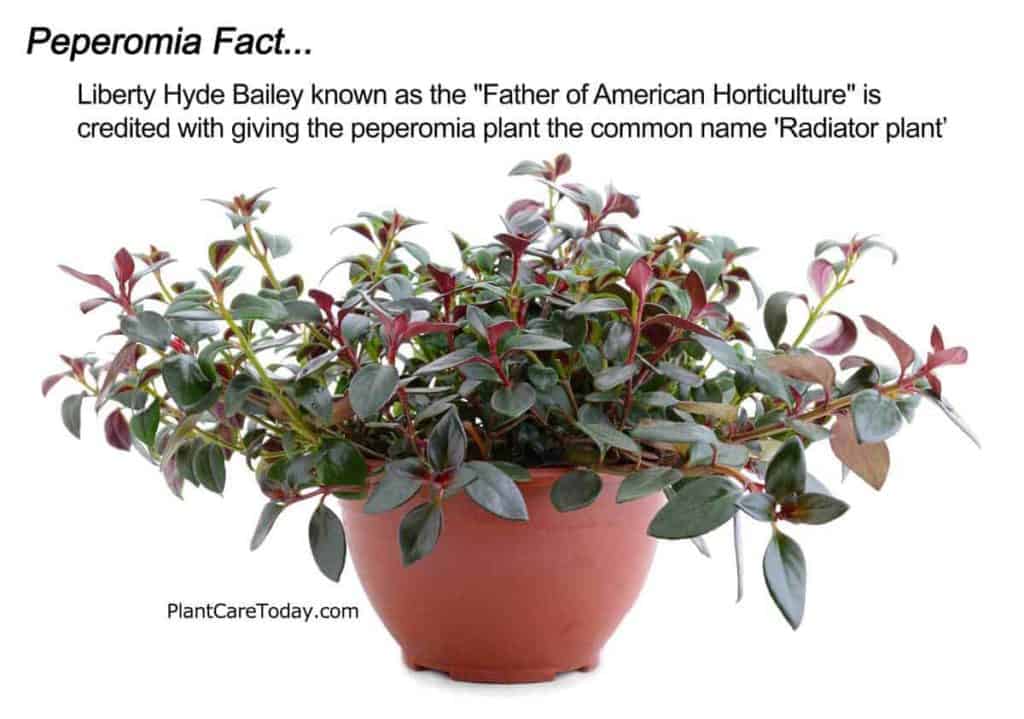 The peperomia plant was given the common name “Radiator Plant” by Bailey
The peperomia plant was given the common name “Radiator Plant” by Bailey
Quick Peperomia Watering and Feeding Care Guide
Peperomia Plant Care Tip: Watch out for over watering your plants. Water plants every 7 – 10 days should be enough, depending on the time of year and temperature.
Peperomias resent overwatering and will rot off at the base. Personally, I like to allow the soil to dry completely before watering again. This will greatly help prevent roots from rotting aka root rot.
Apply a balanced liquid plant food every 3rd time you water during the “growing season” aka the summer months.
Potting Mix and Transplanting
Generally, peperomias do not need repotting. In fact, they do better under potted than over potted. When growing keep the pot size small.
However, repot when the plant becomes too large for its pot. When you plant peperomia, use a well-draining potting mix (50% peat moss / 50% perlite).
Grooming Peperomia Plants
At any time of the year, if your plant gets scraggly or out of hand, it may require pruning
The leaves, growth and foliage of the baby rubber plant come in many forms including:
- A single solid color
- Shiny leaves
- Fleshy
- Variegated
- Smooth
- Crinkled
- Small pale green
- Reddish foliage and stems
- Oblong
- Round
- Corrugated
- Trailing
- Erect
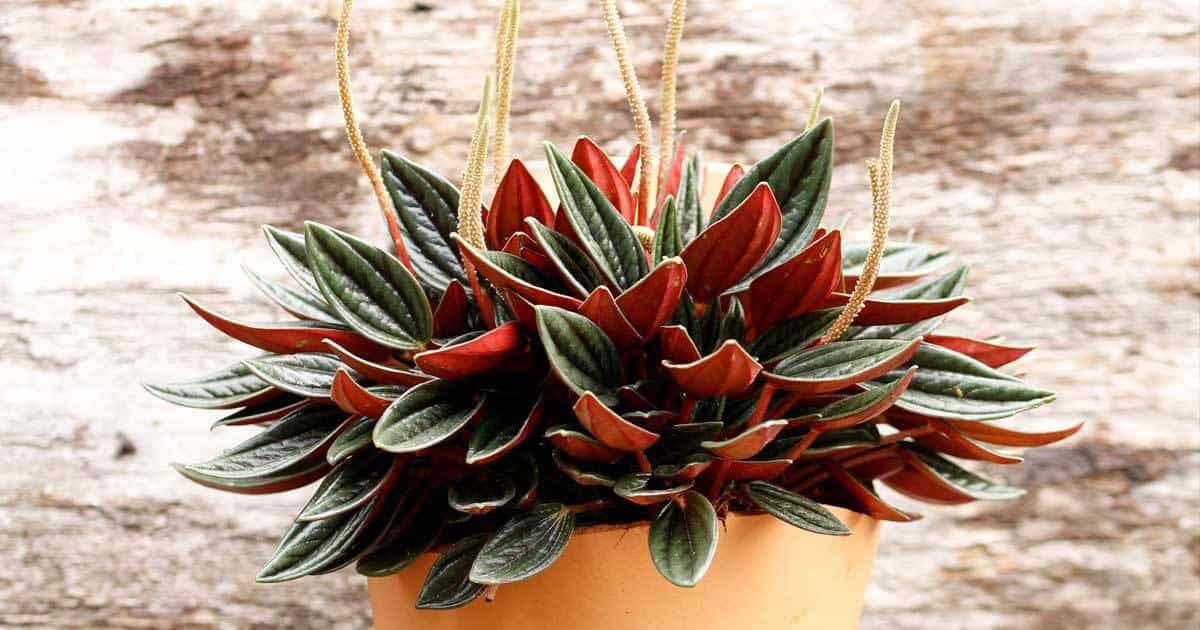 Peperomia Flower Spikes | Another one of the many good small indoor plants!
Peperomia Flower Spikes | Another one of the many good small indoor plants!
How To Propagate Peperomia
Propagating the baby rubber plant is as easy as taking a few tip, leaf or stem cuttings. Using a very light rooting media and dipping the ends in rooting powder, tips and leaves root quickly.
Learning to root peperomia cuttings will help keep plants in shape. They can become straggly and “wild” over time.
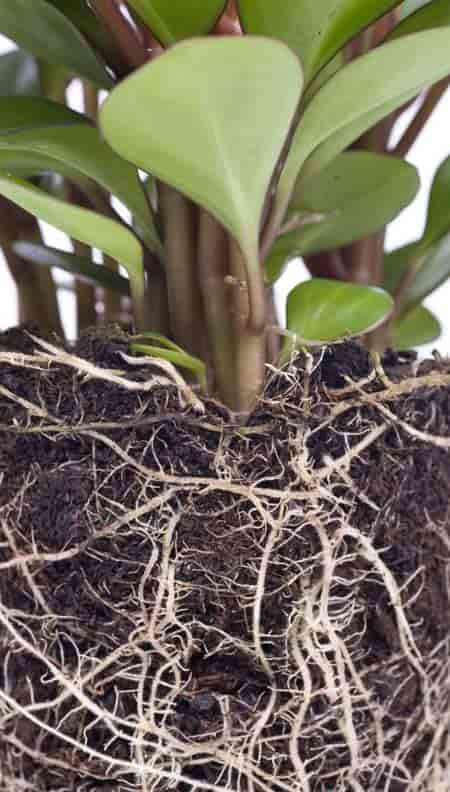 A healthy baby rubber plant peperomia obtusifolia root system
A healthy baby rubber plant peperomia obtusifolia root system
Soil For Rooting
Soil plays an important role in rooting peperomia plants. Since most varieties have small root systems, they make excellent candidates for dish gardens. Use a well-drained potting mix that gets lots of air.
A potting soil like a 50/50 mix of peat moss & perlite, is simple and reliable for rooting and growing peperomia plants.
Leaf Cuttings
Most peperomia plants will propagate from leaf cuttings like African violets. The best time for peperomia propagation is spring, but rooting can also be done in fall.
- Cut off leaf along with a little stem
Stick several of the cuttings in one pot
Press or tamp soil down around cuttings after watering
Cover pot with a plastic bag or “soda bottle” – put several holes in bag or soda bottle
Leave pot in normal room temperature
Remove plastic bag or soda bottle regularly for fresh air and prevent rotting
New plants will start growing from leaf base
When the peperomia plant is rooted well and big enough it can be repotted into individual pots
Tip Cuttings
- Cut off the growing tip along with several leaves
- Remove lowest pairs of leaves
- Dip lower stems into Rootone rooting hormone powder
- Follow the guidelines for leaf cuttings
Peperomia Pest & Disease Problems
Peperomia plants belong to a unique group of plants that have few pests or diseases attacking them. The greatest enemy is probably neglect. When pests like mealybugs show up we reach for the organic insecticide Neem Oil.
Learn More
If you click this link and make a purchase, we earn a commission at no additional cost to you.
Read our Guide on Controlling Radiator Plants Pests and Diseases
However, peperomias do have a few maladies.
Fading Dull Leaves – When peperomia plants have dull-looking leaves, it is usually caused by light which is too strong.
Remedy – Move the plant to more shade.
Discolored Leaves and Flowers – This condition usually happens from overwatering.
Remedy – Allow the potting mix to dry out and avoid getting water on the leaves which can sometimes cause them to rot.
Peperomia Questions & Answers
Roots, Leaves and Stems Rotting
Question: I had a Peperomia obtusifolia plant that was stunted, gradually wilted, withered and died. There was dark stem rot at the soil line and the roots decayed. I plan on buying another baby rubber peperomia plant, probably a variegated Peperomia obtusifolia. How can I avoid killing my future new plant? Libby Bismark, North Dakota
Answer: Libby, this sounds like classic overwatering of peperomia plants growing indoors. Make sure to plant peperomia in well-drained potting soil, avoid overwatering and never allow plants to sit in saucers with water or root rot can become an issue. The plant likes bright indirect light. If you keep the plant in a low light area reduce watering.
Leaves Of Large Plant Dropping Off?
Question: Can you tell me why the leaves of my large watermelon peperomia plant are dropping off? I’ve grown it as a houseplant for a number of years and would hate to lose it. Darcy Lincoln, Nebraska
Answer: Darcy, the leaf drop on your plant may be taking a natural rest and signals its need by dropping the older leaves. If this is the case, do not water as often and withhold all plant food until new growth is obvious.
HOWEVER… If it has not been repotted in fresh soil in a long time, this may be the time to repot.
Be certain that the base of the plant has not rotted.
If this happens, the ends of the stems where they join the base of the plant turns to watery, tan colored mush.
Peperomia plants sometimes rot in this manner when overwatered, especially in soil that does not drain readily.
Your houseplant was originally potted in spongy, loose soil. However, over time the soil breaks down into smaller particles and compacts reducing its ability to properly drain water.
If you diagnose the trouble as plant or root rot, spread a newspaper out on your kitchen table, tap the plant and soil out of the pot.
Shake the soil away and wash roots clean so you can determine what portion of the plant has rotted and what part is still healthy.
Using a sharp knife, or pruning shears salvage the parts of the plant that have not yet rotted.
Peperomia plants form many rosettes of leaves as they mature. To root one of these, remove the lower leaves and dust the cut portions with a rooting hormone (such as Rootone if you have it), and insert in moist, fresh soil.
Placed back in a sunny window and with proper care, the cutting should produce roots quickly and form a handsome new plant with leaves in a few months.
Popular Varieties Of Peperomia Species
Peperomia Argyreia – “Watermelon Peperomia” variegated leaves resembling the patterns found on watermelon rinds. An easy care indoor plant.
Peperomia Caperata (Emerald Ripple), – the flower axils resemble ‘mouse tails” (as do all peperomia plants) stand above the leaves. Caperata is one of the most popular peperomia varieties.
There are several selected “sports” and varieties that resemble Caperata such as:
- Peperomia Frost with silver frosted leaves
- Peperomia Rosso a variety growing in popularity
- Peperomia Albovittata Piccolo Banda – succulent silvery green, heavy veining, red stems
- Peperomia San Marino – grayish green leaves
- Peperomia Napoli Nights – The oval shaped leaves, grey-green color pattern on the upper surface, the underside are pink-red
- Peperomia Moonlight – has grey-green leaves with green veins. Peperomia ‘Napoli Nights’ looks similar.
Peperomia “Mouse Tails” Caperata
 Its origin – the Brazilian rainforest. Grown as a small houseplant, no more than about 8″ inches tall, the plant is characterized by its dark green wrinkled leaves no “real” stalks.
Its origin – the Brazilian rainforest. Grown as a small houseplant, no more than about 8″ inches tall, the plant is characterized by its dark green wrinkled leaves no “real” stalks.
The tiny (seen through a magnifying glass) yellow-white flowers emerge on the “mouse tails” standing above the crinkled, corrugated foliage.
This is a list of some available peperomias sometimes called the “baby rubber plant”. There are some beauties of stiff, upright habit. These are the dangling and spreading varieties, with a wide variety of foliage design.
Peperomia clusiifolia ‘Ginny’ – Know as ‘Rainbow’ or ‘Tricolor’ large medium green leaves, creamy white edges with rosy-pink blushes.
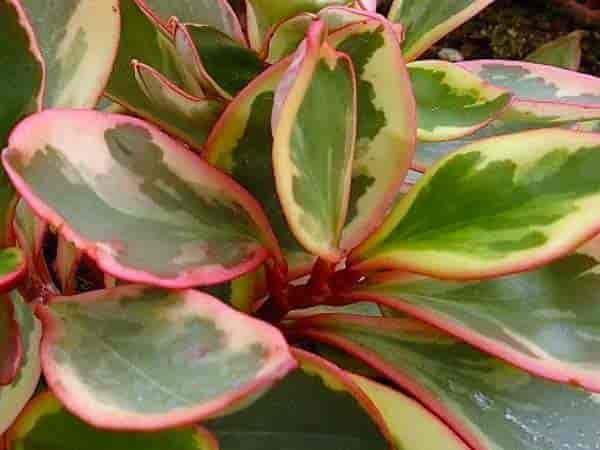 Variegated baby rubber plant PeperomiaPeperomia cubensis (rotundifolia, ‘Yerba Linda’) – Branching, red-tinged stems with pointed-oval, gray-green foliage divided by precise indented veins. The variegated form is dashingly splashed with creamy white.
Variegated baby rubber plant PeperomiaPeperomia cubensis (rotundifolia, ‘Yerba Linda’) – Branching, red-tinged stems with pointed-oval, gray-green foliage divided by precise indented veins. The variegated form is dashingly splashed with creamy white.
Peperomia dolabriformis, the “prayer peperomia,” has fleshy spatulate leaves that fold together and resembles pea pods or small purses, and displays a pale green translucent layer across the leaf’s upper edge.
Peperomia ferreyrae (pincushion peperomia) small semi-succulent perennial, lime green peapod shaped leaves, tiny yellow flowers.
Peperomia fosteri – Deep, dull-green pointed leaves with lighter veins; branches low and spreading.
Peperomia graveolens (ruby glow) – sprouts wine red color leaves, easy care, does not like cold.
Peperomia glabella – Glossy gray-green leaves tapering to a point, on lax, thin stems. The variegated version sports a white border.
Peperomia Hope – hybrid between peperomia quadrifolia and peperomia deppeana. It’s eye-catching appearance also makes perfect for a window container or terrarium.
Peperomia incana (felted pepperface) – easy to care for, heart-shaped leaves covered in small white hairs, grow potted or as a hanging basket.
Peperomia Nivalis – (Succulent) upright, climber, dark green oval leaves, fleshy stems, creamy gold variegation, panicle rosette.
Peperomia obtusifolia – pepper face – Popular florist, dark green leaf, a dish-garden plant with thick, succulent like cupped leaves carrying an almost baby rubber plant appearance. This plant sports freely, with variegated, miniature, variegated miniature, albino, white-edged, and ‘Gold Tip’ varieties available.
Peperomia pellucida – shiny bush – Fleshy, heart-shaped, shiny leaves, with succulent stems, grows in damp, shaded, tropical habitats.
Peperomia pepperspot – red tinged stem, glossy, green leaves, ideal for small spaces.
Peperomia orba – known as the teardrop peperomia, a tropical plant that does well indoors.
Peperomia orba ‘Pixie’ has attractive, furry, grayish-green leaves.
Peperomia polybotrya – coin leaf peperomia – succulent like large green heart-shaped glossy leaves, and very easy to care for. Keep away from cold, allow the soil mix to dry between watering. The green glossy leaves are sometimes circular on young plants. Grow outdoors in USDA hardiness zone 10.
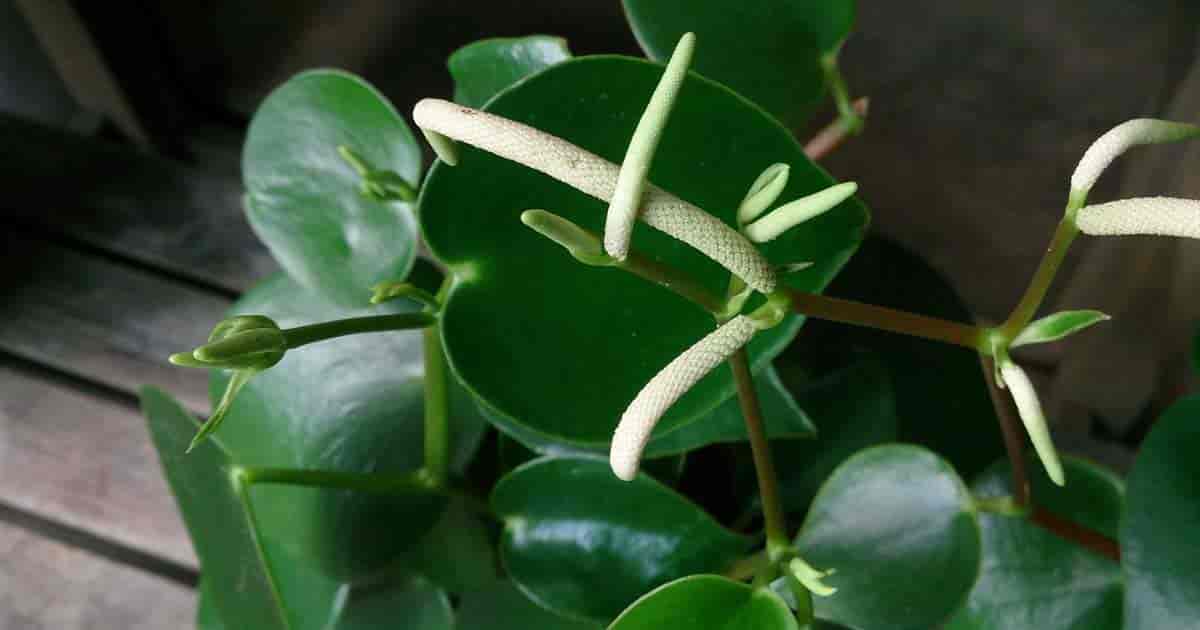 Peperomia polybotrya ‘Jayde’ known as the coin peperomia – Image By Mokkie CC BY-SA 3.0, from Wikimedia Commons
Peperomia polybotrya ‘Jayde’ known as the coin peperomia – Image By Mokkie CC BY-SA 3.0, from Wikimedia Commons
Peperomia puteolata – “parallel peperomia” the leaf pattern looks similar to “watermelon pep” with more elongated leaves.
Peperomia prostrata – ‘String of Turtles’ – Tiniest trailer or creeper with threadlike stems stringing together perfect little blue button leaves, etched with a pattern of silver. This one may be reluctant to move about, takes a while to adjust to any new quarters.
Peperomia ‘Rosso’ and attractive sport of Peperomia Caperata (Emerald Ripple)
Peperomia rubella – (Red Trailing Peperomia) Makes an attractive hanging basket.
Peperomia Ruby Cascade – (Ruby Peperomia) small plant with reddish trailing dark leaf vine-like stems, rounded succulent leaves, pink flowers.
Peperomia quadrangularis – Low creeper with dull bronze-green leaves indented with yellowish veins.
Peperomia rotundifolia – thin stems, rounded leaves with a trailing growth habit
Peperomia serpens – Sturdy trailer with glossy green, heart-shaped leaves.
Peperomia trinervis – Creeper or trailer with small pointed leaves marked deeply with parallel veins.
Peperomia ‘Ginny’
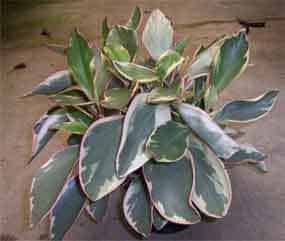 Peperomia Ginny is also known as ‘Tricolor’ or ‘Rainbow,’ is a popular peperomia houseplant and a very tender perennial. It has a thick stem and leaves with green, cream & red color. ‘Ginny’ also has slender spikes of tiny white flowers that occur throughout the year on mature plants.
Peperomia Ginny is also known as ‘Tricolor’ or ‘Rainbow,’ is a popular peperomia houseplant and a very tender perennial. It has a thick stem and leaves with green, cream & red color. ‘Ginny’ also has slender spikes of tiny white flowers that occur throughout the year on mature plants.
As with most Peperomias, ‘Ginny’, generally, is easy to grow and can add color to your garden. It is best in containers because of its large leaves and upright growth habit. Peperomia ‘Ginny’ can also be used as a groundcover with its ability to tolerate heat or shade.
 The peperomia plant was given the common name “Radiator Plant” by Bailey
The peperomia plant was given the common name “Radiator Plant” by Bailey
 A healthy baby rubber plant peperomia obtusifolia root system
A healthy baby rubber plant peperomia obtusifolia root system
 Variegated baby rubber plant Peperomia
Variegated baby rubber plant Peperomia Peperomia polybotrya ‘Jayde’ known as the coin peperomia – Image By Mokkie CC BY-SA 3.0, from Wikimedia Commons
Peperomia polybotrya ‘Jayde’ known as the coin peperomia – Image By Mokkie CC BY-SA 3.0, from Wikimedia Commons